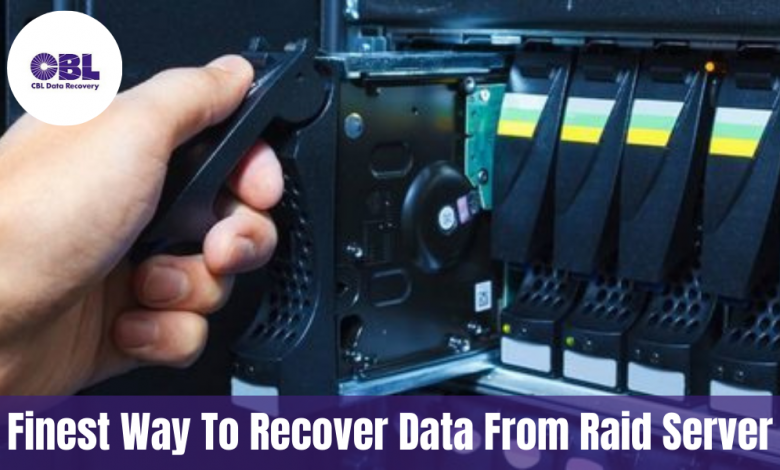Finest Way To Recover Data From RAID Server

Some companies require a large data storage capacity. That’s why, RAID gained amazing popularity for improving transmission speed and providing fault tolerance. From small to medium-sized businesses, organizations are choosing the RAID to keep their critical data safe. Additionally, RAID is considered as the safer and more reliable option to organize the data in different locations. It combines the capacity of several inexpensive disks to optimize system storage. However, RAID can also experience data loss and disk failures. The reason for data loss can be several, including accidental deletion or formatting, which further directly affect the business revenue. In these situations, contacting a professional data recovery service provider sighs relief in recover data from the RAID server.
Here are the following methods of RAID data recovery. This write-up will share the basic knowledge of RAID and the best way to recover data from RAID.
Table of Content
What is RAID?
How to Recover Data From RAID Server?
- Steps to Recover Data From RAID Server
Wrapping Up!
What is RAID?
RAID stands for Redundant Array of Independent Disks. Most computers only have one hard drive. Hence, capacity, speed, and reliability are quite limited. To overcome these problems, people have developed a way to combine multiple less expensive disks into one volume with more capacity and speed. In short, RAID is super storage with multiple hard drives.
In addition to more storage capacity and faster speeds, redundancy is another major advantage of RAID. When a disk fails due to hardware issues, RAID redundancy protects against data loss, although it doesn’t work for malware and theft.
RAID has levels at which disks are combined. In the consumer and small business markets, there are three most common levels: RAID 0, RAID1, and RAID 5.
- RAID 0: It stripes data across multiple disks for faster read and writes speeds for better performance. However, RAID 0 doesn’t provide protection against disk failure because it does not provide data redundancy. When a disk fails, your data may very well disappear.
- RAID 1: It writes and reads the same data across pairs of drives, offering to mirror. This is the simplest and easiest way to create fault-tolerant disk storage, but it costs 50 per cent of the total storage capacity.
- RAID 5: It offers both speed and data redundancy. This writes and reads data from multiple disks and distributes parity data across all disks in an array. So, any disk can fail without an entire array crashing or data loss.
Other RAID levels include 6, 10, 5 + 1, JBOD, Microsoft virtual disk RAID and others.
How to Recover Data From RAID Server?
There are several reasons for data loss from the RAID server. Sometimes, it becomes cumbersome to recognise the exact reason for data loss. And hence, a data recovery operation becomes more complex in such cases. A minor mistake may lead to permanent data loss.
If data loss occurs, it’s time to check its Server, RAID controller, RAID configuration, or any other component related to RAID setup. The other reason for data loss could be RAID malfunction or damage to the disk.
If data loss occurs due to damaged disks, the cause of this would be physical, logical damage, or both. Physical damage means a physical crack or break of disks, which end up with disturbing noises, overheating, or other indications. On the other side, logical damage is a malfunction in the software available in the disks. For example, virus attacks or file system corruption are some of the examples of logical damage.
Steps to Recover Data From RAID Server
- Step 1: For starting the procedure of recovering data from a damaged disk, the first step is to open the disks and examine the cause of damage in the Class 100 Clean Room Lab. It has a controlled level of airborne particles. During disk examination, such an atmosphere prevents any accidental damage to the disk.
- Step 2: If physical damage occurs, it’s time to replace the broken or damaged components with the appropriate ones. In this scenario, you require the assistance of technical experts as it is a more complex task.
- Step 3: When the disks have become operative, you need to clone them using specialized data recovery software.
- Step 4: Once done with the cloned part, the next step is to discover the logical parameters of the RAID array. These parameters are strip capacity, RAID level, data flow pattern, and parity flow information. It’s possible with the use of specialized tools, procedures, and expertise.
- Step 5: You can rebuild it after being aware of various RAID parameters.
- Step 6: At last, for performing the data recovery, you would need to run software that performs file signature-based scanning of the disks. It’s also known as deep cleaning.
Hence, the RAID data recovery is a challenging task that doesn’t only require advanced expertise but also specialize in handling various tools. While examining the disk, try to identify the exact reason for failure. However, you must also keep yourself careful for fixing RAID errors or failure, as the loss of your business data stored on the RAID disks might bring huge losses to your business.
For avoiding permanent data loss or an entire RAID failure, what could be a more reliable option than hiring a professional data recovery service provider who has expertise in RAID data recovery. Several organizations have various tools and techniques for restoring the data.
Wrapping Up!
Given that RAID is widely used, it makes sense that RAID data recovery becomes an essential skill. Based on the above write-up, you can perceive how cautiously it’s to get lost files back from RAID. As a powerful storage device, RAID is also at risk of data loss. There are various tools that aren’t only easy to use but also capable of recovering lost files from RAID. For example, the professionals of RAID and other data recovery Singapore provide their services to a fine degree along with high-quality services.
Therefore, in order to choose such services, it’s necessary to include some essential factors like experiences, history, reviews, and their responsibilities regarding services. These aspects will help in choosing the appropriate data recovery specialists.




